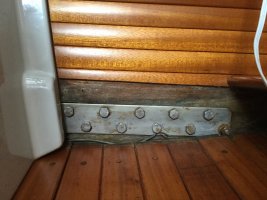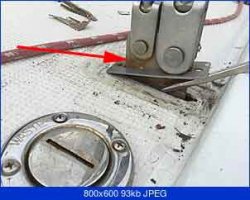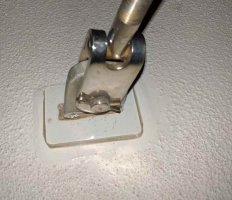Hello all,
We got a survey when we bought this boat earlier this year. 1975 Ericson 35 MK-II "Venus". I asked they guy if the chainplate leak would compromise the deck core, but he assured me that it was a good boat and the deck was sealed with epoxy around the hole where the chainplate protrudes and that water could not reach the core.
After recent Northern California rains, we found a cushion in the settee to be soaked. Today, I removed old sealant from the deck and around the chainplate. There's not much room to poke around in there, but it appears that the core could be wet. I don't want to re seal the thing if there's more work to be done, but is it necessary to remove the chainplate? The deck is not at all spongy.
I removed the wood trim that covers the chainplate inside and it appears that someone has fiberglassed over the bulkhead under the chainplate. I'm also curious why the bulkhead was covered with that paneling. That photo does not want to rotate, sorry.
So many mysteries here and so much to learn. I'm experienced with repairing just about everything but boats... thank you in advance for any advice.

We got a survey when we bought this boat earlier this year. 1975 Ericson 35 MK-II "Venus". I asked they guy if the chainplate leak would compromise the deck core, but he assured me that it was a good boat and the deck was sealed with epoxy around the hole where the chainplate protrudes and that water could not reach the core.
After recent Northern California rains, we found a cushion in the settee to be soaked. Today, I removed old sealant from the deck and around the chainplate. There's not much room to poke around in there, but it appears that the core could be wet. I don't want to re seal the thing if there's more work to be done, but is it necessary to remove the chainplate? The deck is not at all spongy.
I removed the wood trim that covers the chainplate inside and it appears that someone has fiberglassed over the bulkhead under the chainplate. I'm also curious why the bulkhead was covered with that paneling. That photo does not want to rotate, sorry.
So many mysteries here and so much to learn. I'm experienced with repairing just about everything but boats... thank you in advance for any advice.

Attachments
Last edited by a moderator:




